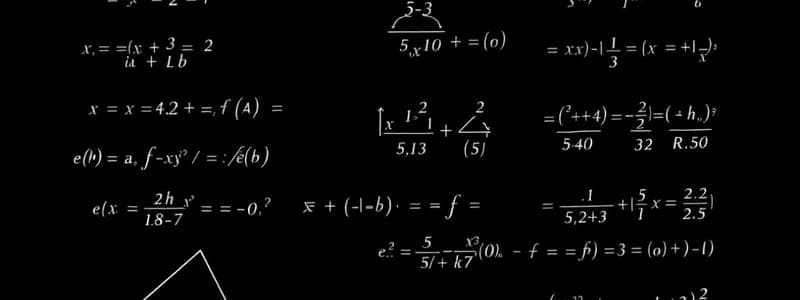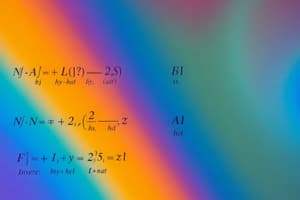Podcast
Questions and Answers
If $x$, $y$, and $z$ are in Arithmetic Progression, and $\tan x$, $\tan y$, and $\tan z$ are also in Arithmetic Progression, where $x, z > 0$ and $xz < 1$, $y < \frac{1}{2}$, $z < 1$, which of the following relationships must be true?
If $x$, $y$, and $z$ are in Arithmetic Progression, and $\tan x$, $\tan y$, and $\tan z$ are also in Arithmetic Progression, where $x, z > 0$ and $xz < 1$, $y < \frac{1}{2}$, $z < 1$, which of the following relationships must be true?
- $6x = 4y = 3z$
- $2x = 3y = 6z$
- $6x = 3y = 2z$
- $x = y = z$ (correct)
Given that $\tan(x+2) + \tan(x-2) - \tan(\frac{1}{2}) = 0$, what is one possible value of $x$?
Given that $\tan(x+2) + \tan(x-2) - \tan(\frac{1}{2}) = 0$, what is one possible value of $x$?
- 1 (correct)
- 2
- -1
- $\frac{1}{2}$
If an angle $\theta$ in the interval $[0, 2\pi]$ satisfies both $\cot \theta = \sqrt{3}$ and $\sqrt{3} \sec \theta + 2 = 0$, then what is the value of $\theta$?
If an angle $\theta$ in the interval $[0, 2\pi]$ satisfies both $\cot \theta = \sqrt{3}$ and $\sqrt{3} \sec \theta + 2 = 0$, then what is the value of $\theta$?
- $\frac{11\pi}{6}$
- $\frac{5\pi}{6}$
- $\frac{7\pi}{6}$ (correct)
- $\frac{\pi}{6}$
In a triangle, the angles are in the ratio 5:1:6. What is the ratio of the smallest side to the greatest side?
In a triangle, the angles are in the ratio 5:1:6. What is the ratio of the smallest side to the greatest side?
If the sides $a, b, c$ of a triangle are in Arithmetic Progression, what is the value of $a \cos^2(\frac{A}{2}) + c \cos^2(\frac{C}{2})$?
If the sides $a, b, c$ of a triangle are in Arithmetic Progression, what is the value of $a \cos^2(\frac{A}{2}) + c \cos^2(\frac{C}{2})$?
If $\cos x = a$ where $0 < x < 1$, and $\sin^{-1}(x\sqrt{1-x^2}) + \sec^{-1}(\frac{1}{2x^2-1}) = \frac{\pi}{3}$, determine the expression for $a$.
If $\cos x = a$ where $0 < x < 1$, and $\sin^{-1}(x\sqrt{1-x^2}) + \sec^{-1}(\frac{1}{2x^2-1}) = \frac{\pi}{3}$, determine the expression for $a$.
If $0 < x < 1$, what is the simplified form of $\sqrt{1 + x^2} \cdot [{\cos(\cot^{-1}x) + \sin(\cot^{-1}x)} ^{-1}]^{\frac{1}{2}}$?
If $0 < x < 1$, what is the simplified form of $\sqrt{1 + x^2} \cdot [{\cos(\cot^{-1}x) + \sin(\cot^{-1}x)} ^{-1}]^{\frac{1}{2}}$?
In a triangle ABC with usual notations, what expression is equivalent to $2ac \sin^2(\frac{A - B + C}{2})$?
In a triangle ABC with usual notations, what expression is equivalent to $2ac \sin^2(\frac{A - B + C}{2})$?
Determine the number of values of $x$ in the interval $(0, 5\pi)$ satisfying the equation $3\sin^2x - 7\sin x + 2 = 0$.
Determine the number of values of $x$ in the interval $(0, 5\pi)$ satisfying the equation $3\sin^2x - 7\sin x + 2 = 0$.
If $\tan^{-1}(\frac{1}{4}) + \tan^{-1}(\frac{1}{9}) = \frac{1}{2}\cos^{-1}x$, then what is the value of $x$?
If $\tan^{-1}(\frac{1}{4}) + \tan^{-1}(\frac{1}{9}) = \frac{1}{2}\cos^{-1}x$, then what is the value of $x$?
Given $\cos^{-1}(\frac{12}{13}) = \sin^{-1}P$, what is the value of $P$?
Given $\cos^{-1}(\frac{12}{13}) = \sin^{-1}P$, what is the value of $P$?
In a triangle $ABC$, if $I(AB) = \sqrt{23}$ units, $I(BC) = 3$ units, and $I(CA) = 4$ units, then find the value of $\frac{\cot A + \cot C}{\cot B}$.
In a triangle $ABC$, if $I(AB) = \sqrt{23}$ units, $I(BC) = 3$ units, and $I(CA) = 4$ units, then find the value of $\frac{\cot A + \cot C}{\cot B}$.
Flashcards
Arithmetic Progression of Tangents
Arithmetic Progression of Tangents
If x, y, z are in Arithmetic Progression (AP) and tan x, tan y, tan z are also in AP, with x, z > 0 and xz < 1, and y < 1, then 6x = 3y= 2z
Angle satisfying trigonometric equations
Angle satisfying trigonometric equations
Angle (\theta) in [0, 2(\pi)] that satisfies both cot (\theta) = (\sqrt{3}) and (\sqrt{3}) sec (\theta) + 2 = 0 is 7(\pi)/6.
Ratio of triangle sides
Ratio of triangle sides
If the angles of a triangle are in the ratio 5:1:6, the ratio of the smallest side to the greatest side is (\sqrt{3}) - 1 : 2(\sqrt{2}).
Triangle sides in AP
Triangle sides in AP
Signup and view all the flashcards
a in Trigonometric Equation
a in Trigonometric Equation
Signup and view all the flashcards
Trigonometric simplification
Trigonometric simplification
Signup and view all the flashcards
Triangle Identity
Triangle Identity
Signup and view all the flashcards
Study Notes
Trigonometric Functions
- If x, y, z are in Arithmetic Progression (AP) and tan x, tan y, tan z are also in AP, where x, z > 0 and xz < 1, y < 1, then 6x = 3y = 2z.
- If tan⁻¹(x + 2) + tan⁻¹(x - 2) = tan⁻¹(1/2), then x = 1/2.
- If angle θ in [0, 2π] satisfies cot θ = √3 and √3 sec θ + 2 = 0, then θ = 7π/6.
- If the angles of a triangle are in the ratio 5:1:6, the ratio of the smallest side to the greatest side is √3 - 1 : 2√2.
- If the sides of a triangle a, b, c are in A.P., then with usual notations, a cos²(A/2) + c cos²(C/2) = 3b/2.
- If cos⁻¹x = a (0 < x < 1) and sin⁻¹(√(1 - x²)) + sec⁻¹(1/(2x² - 1)) = π/2, then a = 1/√2.
- If 0 < x < 1, then √1 + x²[{x cos(cot⁻¹x) + sin(cot⁻¹x)}²]⁻¹/² is equal to x.
- In a triangle ABC, with usual notations, 2ac sin((A - B + C)/2) is equal to c² + a² - b².
- The number of values of x in the interval (0, 5π) satisfying the equation 3sin²x - 7sinx + 2 = 0 is 5.
- If tan⁻¹(1/4) + tan⁻¹(1/2) = cos⁻¹x, then x is 3/√5.
- If cos⁻¹(√12/13) + sin⁻¹(3/5) = sin⁻¹P, then the value of P is 5√3/65.
- In a triangle ABC, I(AB) = √23 units, I(BC) = 3 units, I(CA) = 4 units, then (cot A + cot C) / cot B is 4.
Studying That Suits You
Use AI to generate personalized quizzes and flashcards to suit your learning preferences.




